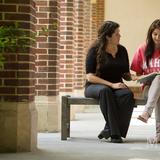- The primary mission of Schenectady County Community College is to provide comprehensive higher education and adult education opportunities of the highest quality through academic, career-technical, professional, and personal enrichment programs in response to local educational needs and at low cost to students.
School Highlights
Schenectady County Community College serves 4,861 students (23% of students are full-time).
The college's student-teacher ratio of 17:1 is higher than the state community college average of 13:1.
Minority enrollment is 41% of the student body (majority Black and Asian), which is less than the state average of 62%.
Quick Facts (2025-26)
- Enrollment: 4,861 students
- In-state tuition: $3,861
- Out-state tuition: $7,317
- Student-teacher ratio: 17:1
- Minority enrollment: 41%
- Source: Verified school update
Top Rankings
Schenectady County Community College ranks among the top 20% of public schools in New York for:
Category
Attribute
Affordability
School Overview
The teacher population of 282 teachers has stayed relatively flat over five years.
Schenectady County Community College
(NY) Community College Avg.
Carnegie Classification
Associate's Colleges: High Transfer-High Nontraditional
Baccalaureate/Associate's Colleges: Mixed Baccalaureate/Associate's
Institution Level
Less than 2 yrs
At least 2 but less than 4 years
Institution Control
Public
Private not-for-profit
Total Faculty
282 staff
159 staff
School Calendar
Student Body
The student population of Schenectady County Community College has stayed relatively flat over five years.
The student-teacher ratio of 17:1 has increased from 14:1 over five years.
The Schenectady County Community College diversity score of 0.61 is less than the state average of 0.76. The school's diversity has grown by 7% over five years.
Total Enrollment
4,861 students
1,129 students
Student-Teacher Ratio
17:1
13:1
# Full-Time Students
1,125 students
528 students
# Part-Time Students
3,736 students
601 students
# Enrollment Undergraduate
486 students
357 students
# Full-Time Undergraduate Students
1,125 students
519 students
# Full-Time Graduate Students
n/a
44 students
# Part-Time Undergraduate Students
n/a
850 students
# Part-Time Graduate Students
n/a
41 students
Total Dormitory Capacity
n/a
382 students
% American Indian/Alaskan
1%
n/a
% Asian
13%
8%
% Hispanic
7%
23%
% Black
14%
18%
% White
59%
38%
% Hawaiian
n/a
2%
% Two or more races
3%
3%
% Non Resident races
n/a
3%
% Unknown races
2%
5%
Diversity Score
0.61
0.76
College Completion Rate (Students who graduate in less than 4 years)
27%
33%
College Completion Rate (Students who graduate in 4 years or more than 4 years)
n/a
40%
Average Graduate Earnings (10 Years)
$33,300
$35,200
Tuition and Acceptance Rate
The public in-state tuition of $3,861 is less than the state average of $5,902. The in-state tuition has declined by 30% over four years.
The public out-state tuition of $7,317 is less than the state average of $10,404. The out-state tuition has declined by 29% over four years.
In-State Tuition Fees
$3,861
$5,902
Out-State Tuition Fees
$7,317
$10,404
% Students Receiving Some Financial Aid
84%
88%
Median Debt for Graduates
$10,362
$13,841
Median Debt for Dropouts
$5,500
$5,500
Acceptance Rate
n/a
74%
SAT Reading
n/a
475
SAT Math
n/a
505
SAT Writing
n/a
485
ACT Composite
n/a
20
ACT English
n/a
18
ACT Math
n/a
20
Source: 2024 (or latest year available) Integrated Postsecondary Education Data System (IPEDS) , School Administrators
School Notes
- Schenectady County Community College, established in 1967, is part of the State University of New York (SUNY) system. The College emphasizes high quality academic programs, broad access for students, and responsiveness to the needs of the community. SCCC offers a wide range of transfer degree, career degree and certificate programs. The College has committed, accessible teaching faculty and an attractive campus, located in Schenectady along the Mohawk River - in the heart of the New York State Capital District. Schenectady County Community College offers the following Transfer, Career, and Certificate programs. In striving to achieve its primary mission, the College affords students the opportunity to earn Associate in Arts (A.A.), Associate in Science (A.S.), Associate in Applied Science (A.A.S.) and Associate in Occupational Studies (A.O.S.) degrees in college parallel or career technology programs. The College also provides students with the opportunity to earn certificates in specialized career fields or personal development activities. SCCC operates as a comprehensive community college under the programs and standards of the State University of New York. Sponsored by Schenectady County, the College is accredited by the Commission on Higher Education of the Middle States Association of Colleges and Schools.
Frequently Asked Questions
How much does Schenectady County Community College cost?
Schenectady County Community College's tuition is approximately $3,861 for In-State students and $7,317 for Out-State students.
What is Schenectady County Community College's ranking?
Schenectady County Community College ranks among the top 20% of community college in New York for: Least expensive tuition.
Recent Articles

The Rise of Technical and Vocational Training in 2025
Explore the 2025 surge in technical and vocational training—enrollment, policy, costs, and why this path is gaining ground for students and parents.

Stackable Credentials: How Community Colleges Advance Careers
Discover how community colleges use stackable credentials to build career pathways, boost earnings, and enable lifelong learning in 2025.

High-Paying Jobs You Can Get with a Community College Degree
Discover top high-paying careers you can launch in 2025 with a community college (associate) degree and high-growth credentials in tech, healthcare and trades.










